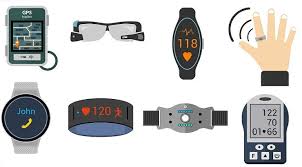Technology is transforming healthcare, and wearable IoT (Internet of Things) devices are at the center of this change. From smartwatches that track heart rates to advanced biosensors that detect early signs of illness, these devices are making healthcare faster, more personalized, and more proactive.
In 2025, real-time patient monitoring is no longer a luxury — it’s becoming an essential part of medical care, both inside hospitals and at home.

What Are Wearable IoT Devices in Healthcare?
Wearable IoT devices are internet-connected gadgets worn on the body to collect, send, and sometimes analyze health data.
Examples include:
- Smartwatches (Apple Watch, Fitbit)
- Continuous Glucose Monitors (CGMs)
- Wearable ECG Monitors
- Smart Clothing with Sensors
- Medical Patches for vital signs
These devices connect to mobile apps or healthcare platforms, sending real-time updates to doctors, caregivers, or emergency responders.
Why Real-Time Monitoring Matters
Traditionally, doctors only had a “snapshot” of a patient’s health during check-ups. But real-time monitoring means continuous, 24/7 insight into vital signs.
Benefits include:
- Early Detection of Health Issues – Alerts when readings go beyond safe limits.
- Better Chronic Disease Management – Constant data for conditions like diabetes, heart disease, and asthma.
- Fewer Emergency Visits – Problems can be addressed before they escalate.
- Peace of Mind for Families – Caregivers can track patients remotely.
Case Study 1: Apple Watch and Heart Monitoring
The Situation:
Apple’s ECG feature allows users to record an electrocardiogram directly from their wrist.
Impact:
- In multiple documented cases, the watch detected irregular heart rhythms (atrial fibrillation) and prompted users to seek urgent care.
- Doctors were able to intervene early, preventing potential strokes.
Case Study 2: Dexcom G7 for Diabetes Management
The Situation:
Dexcom’s G7 Continuous Glucose Monitor tracks glucose levels in real time and sends alerts to the patient’s phone and healthcare providers.
Impact:
- Reduces the need for finger-prick tests.
- Helps patients adjust diet, exercise, or medication instantly.
- Improves overall blood sugar control, reducing long-term complications.
Case Study 3: BioIntelliSense BioSticker
The Situation:
The BioSticker is a medical-grade wearable that continuously measures temperature, respiratory rate, heart rate, and more.
Impact:
- Used in post-surgery recovery to detect complications early.
- Enables remote patient monitoring after hospital discharge, freeing up beds.
Real-World Applications in 2025
1. Post-Operative Care
Patients recovering at home can be tracked for signs of infection, irregular heartbeats, or breathing issues.
2. Elderly Care
Wearables with fall detection and emergency alerts allow seniors to live independently longer while staying safe.
3. Sports Medicine
Athletes use IoT wearables to prevent injuries by tracking fatigue, hydration, and muscle strain.
4. Pandemic Response
During outbreaks, wearables can help detect early symptoms (like fever or low oxygen) and prevent spread.
Benefits for the Healthcare System
- Reduced Hospital Overcrowding – More patients can be monitored remotely.
- Cost Savings – Early detection reduces expensive emergency treatments.
- Data-Driven Decisions – Continuous data helps doctors make better treatment plans.
Challenges to Overcome
- Data Privacy – Sensitive health data must be protected from cyberattacks. Breaches could expose personal medical histories, insurance details, and other confidential information, leading to identity theft or misuse. Strong encryption and compliance with regulations like HIPAA are essential.
- Accuracy – Not all consumer-grade wearables meet medical standards. Inaccurate readings can lead to false alarms or missed warning signs, which could harm patients. Devices must undergo rigorous clinical testing before being used in healthcare decisions.
- Integration with Health Systems – Devices must work seamlessly with hospital software and electronic health records (EHRs). Poor integration can result in fragmented data, making it harder for doctors to get a complete view of a patient’s condition.
- Patient Adoption – Some patients may resist using technology due to lack of familiarity, cost concerns, or privacy fears. Education, easy-to-use interfaces, and affordable pricing can help encourage broader acceptance.
The Future of Wearable IoT in Healthcare
By 2030, we can expect:
- AI-powered predictions to warn of health risks days in advance.
- Smart implants for continuous internal monitoring.
- Seamless hospital integration for faster treatment decisions.
Final Thoughts
Wearable IoT devices are revolutionizing healthcare by giving doctors and patients the power of real-time insights. As technology advances, these devices will become more accurate, affordable, and widely adopted — making healthcare more proactive and less reactive.
In 2025, the message is clear: wearables are not just gadgets; they’re life-saving tools.





